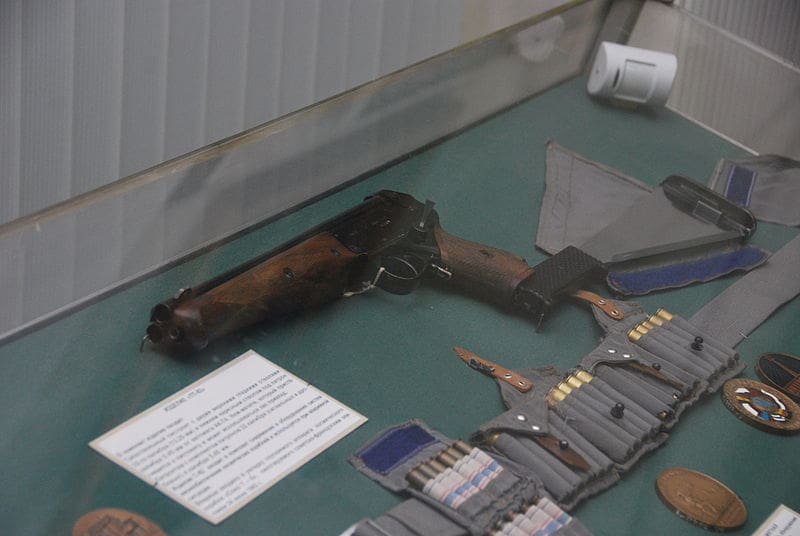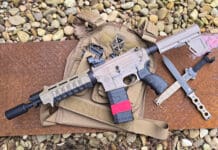
The idea of taking guns into space has a long and scientifically…um…questionable history. It hasn’t been done much in real life (the pictured Soviet TP-82 is a rare exception) but literature abounds with fictitious examples. We’ve been speculating about heat rays, Phasers, and Imperial Laser Blasters for ages, but where does science take you when you start thinking about shooting real guns in space?
Live Science posted a fascinating article about shooting in space, but it offers little practical advice for the Armed Interplanetary Intelligentsia. With that in mind, I thought I’d add some more completely useless space shooting tips of my own.
Yes, guns will fire in space.
Combustion as we know it on Earth is nothing but the rapid oxidation of chemical compounds (typically with atmospheric oxygen) giving off heat and chemical byproducts. There can be no combustion without oxygen in the vacuum of space, but gunpowder and primers contain their own oxidizing agents so they’ll still ignite and propel the bullet out of the barrel.
The muzzle velocity for bullets fired in space could be slightly higher than the muzzle velocity for the same gun and cartridge fired in the Earth’s atmosphere, because the bullet will not have to push the atmosphere out of its way as it speeds down the barrel and out ofthe muzzle. This effect will only show itself if you keep the gun and cartridge at room temperature up until the time of firing, which leads us to the next tip.
Keep your powder warm, or wait for Hodgdon’s ‘Zero K’ space gunpowder.
Some propellants like Cordite are very temperature-sensitive, and were known to produce dangerously high pressures when Professional Hunters left their .477 Nitro Express ammo sitting in the Kenyan sun for too long. At the other end of the thermometer, really cold gunpowder (at 2.7 degrees above absolute zero) doesn’t burn as efficiently as room-temperature gunpowder, and a lot of it might not burn at all.
Proper ammunition handling can avoid this problem. If you keep your gun and cartridges at room temperature (say, inside your spacecraft) and only take them out the airlock briefly to fire them, they should still remain at nearly room temperature for some time and provide optimum ballistic performance.
If firearms in space become a viable market niche (never gonna happen) I’m sure SAAMI would test and certify certain propellants and primers for proper functioning at space temperatures.
Keep your guns cool.
Combustion is, well, hot, and that heat builds up in guns and has to go somewhere. Earthbound guns can cool off relatively quickly, because they benefit from conductive and convective cooling. A hot AR sheds its heat (conduction) to cooler surrounding air molecules, which becomes less dense and rises (convection) and makes room for heavier cooler air, which heats and becomes less dense and rises, etc.
Conduction and convection are why your smoking-hot AR barrel is safe to touch after ten minutes’ rest with the bolt held open. In space, none of this occurs: guns might start out very cold, but they heat up quickly and stay hot for a long time. How long? Black-body radiative cooling is governed by the Stefan-Boltzmann equation, which you’ll have to work out for yourself since I dropped out of college physics:
However the numbers crunch out, I’d bet a box of Barnes Bullets that after a few 30-round mag dumps, your AR’s cooling time will be measured in hours, or even days.
And keep them slightly rusty.
At low temperatures, uncoated metal can adhere strongly to the same uncoated metal. It’s called cold-welding, and it almost never happens on Earth because our oxygen-abundant atmosphere instantly attacks uncoated metals and leaves them coated with a thin layer of oxidation.
One solution to this problem is to make sure your metal gun parts are slightly oxidized, and this is easily accomplished by keeping them with you inside your hypothetical spacecraft. Keep in mind that excessive wear (between the bolt and barrel, or slide and frame) can scrape off the thin oxide layer and allow the parts to cold-weld themselves together forever.
Another solution is to use dissimilar metals in gun construction, to make sure that steel never touches a similar blend of steel anywhere in the gun. Either way, your all-steel 1911 is a good gun to leave Earthside.
Forget everything you thought you knew about ballistics.
As Einstein noted, everything is relative, so once the bullet leaves the barrel it’s only meaningful to speak of impact velocity, the speed of the projectile relative to the velocity of the intended target. This metric, and not muzzle velocity, determines how much damage you’ll do downrange.
Everything in space is moving relative to you. Some are moving toward you and some away from you, and most of them are doing it really quickly. Your AR bullet (which left your gun at 1,000 m/s) can either smash into them at many kilometers a second with the force of a 20mm cannon, or never catch up to them at all.
And projectiles in a microgravity vacuum don’t follow the external ballistics tables in the Speer Reloading Manual. They follow Newton’s First Law Of Motion: an object in uniform motion remains in motion until an external force is applied to it. This means that at 100 meters, or 100 kilometers, or 100,00o, or beyond the disk of the Milky Way galaxy, your bullet will still be traveling at exactly muzzle velocity unless it has hit something or encountered another force (read: gravity) to speed it up or slow it down, relative to the muzzle.
When your bullets don’t suffer any appreciable loss of velocity even at ranges of dozens of kilometers, you might be tempted to mount a 100x scope and take some pretty long shots. Don’t do it: everything in space is moving relative to you, and at ranges of dozens or hundreds of kilometers you’ll have to lead your target by an unknowable amount while compensating for orbital and gravitational perturbations. As the Live Science article points out, you could even end up shooting yourself in the back if you’re in orbit.
Choose your shooting stance carefully.
Newton’s Third Law states that for every action, there is an equal and opposite reaction. All shooters understand this law instinctively, since we’re subjected to recoil every time we drop the hammer. As unsettling as the recoil from your .50 Beowulf is on Earth, it gets much, much worse in microgravity because there’s nothing for you to brace against.
Planetside, we manage recoil by absorbing the force with our muscles, and transmitting some of that absorbed force into the ground through our feet. In microgravity, only the tiniest recoil impulses could be completely absorbed by our muscles, and the recoil from a firearm would send the shooter cartwheeling slowly backwards unless they’d firmly attached themselves to a massive firing platform like their spacecraft.
Firearms meant for use in space could be designed to produce nearly zero recoil impulse, using the principle of the recoilless rifle. Just like a recoilless rifle or RPG, these designs would create a massive blast area behind the shooter.
Conclusion: Why bother?
Only the Russians have ever thought to arm their cosmonauts, and the three-barreled pistol shown above was designed primarily for signaling and fending off wolves in the event of an off-target Soyuz landing. These still occur with remarkable frequency, but Russia has reportedly retired these now-elderly guns and now includes a regular service pistol in their Soyuz survival kits.
NASA never saw a need to send firearms into space; they sent machetes instead. Space is demilitarized by treaty, it’s the ultimate low-crime neighborhood (zero humans=zero crime) and it’s a rotten place to go hunting. Guns in space are as useful as chariots on an aircraft carrier.





Completely irrelevant and worthless information, but interesting nevertheless.
I love it.
Some other considerations relating to temperature:
How might the various gun parts change dimensionally once they are exposed to more extreme cold that they ever would on Earth? A lot would depend on the type of gun. Outer concentric parts would contract more than their inner bearing parts.
How would lubricants behave? Not very well, I would think. I assume, mostly dry lubricants are used in space, if any at all.
How would various metals hold up at extremely low temps. A barrel might become so brittle, the chamber would go kablooie upon the sudden pressure and temperature change upon firing. I have no idea how lead behaves. A lead slug might just shatter into flakes as it exits the barrel.
But, in summation …
http://www.youtube.com/watch?NR=1&feature=endscreen&v=RFZrzg62Zj0
“How would lubricants behave? Not very well, I would think. I assume, mostly dry lubricants are used in space, if any at all.”
I heard this awhile back, but I believe I am stating it correctly: Liquids in microgravity ball up into spheres, so liquid lubricants would actually inhibit firearms from functioning after only a few shots.
“Space is demilitarized by treaty, it’s the ultimate low-crime neighborhood (zero humans=zero crime) and it’s a rotten place to go hunting. Guns in space are as useful as chariots on an aircraft carrier.”
Charming gathering and expansion of space-related firearms information. Enjoyed it. However, the demilitarization is long over, however discrete. Hunting in space is the next huge frontier, as a nuclear warhead from earth, when detonated in space, can send a devastating electromagnetic pulse destroying all communications and navigation satellites in orbit, over a wide arc. This wouldn’t put meat on the table, but would surely bring some chaos to the earth, especially for those relying a bit too much on GPS.
And wait until the Iranian nutcase government develops a nuke to set off an EMP blast about 150 miles up from the center of the US! Complete and long-lasting (1-2 years) collapse of the US power grid! The Democrats will be thrilled, because the US will no longer be polluting the atmosphere and “causing global warming”! Nothing like a return to a hunting-and-gathering economy to lower the population. If you want to get really depressed, read “One Second After”, a novel about an EMP collapsing the grid. Or for a quick reality check, read the 2008 “Report of The Commission to Assess the Threat to the United States from Electromagnetic Pulse (EMP) Attack – Critical National Infrastructures”. (www.empcommission.org)
The first practical space based projectile weapon, and there doubtless will be at some point, is likely to be some form of magnetic propulsion (e.g. rail gun). None of the drawbacks of chemical propulsion, relatively easy to sling big chunks of metal at things, etc.
Only downside will be the power consumption required to fire one, but if you’re in space with guns, chances are that’s been figured out already.
Though you still face the ‘equal and opposite reaction’ with a rail gun. I suspect that radiated energy weapons will be the winner in this race.
But an equal amount of force wouldn’t have the same effect on a space craft as it would on the projectile. At most it would probably cause a small course change, which you would probably just counteract with small thrusters tied into the firing system.
Maybe that was one of the motives behind the gyrojet pistol concept – a weapon with no recoil impulse for the shooter to worry about could be good for shootouts in space.
I read no need for hearing protection…can anyone confirm? Space would probably be more effective than Cerebus for putting AAC out of business.
True. There would be no air to carry the sound wave from firing, so you wouldn’t hear anything. Moot point though, a space suit would likely eliminate the need for hearing protection on Earth.
Except there would/i> be “air.” The escaping gas would still form a sound wave until it dissipated. It would be interesting to know what it sounds like when it impacts your helmet.
Probably a minimal effect if any – escaping gas is going out the muzzle, with no air particles to collide with to change its direction.
Interesting article.
Actually, the whole section on ballistics does exist on planet earth as well. Newton’s Laws and relative motion apply, it’s just that on earth we have to deal with gravity and atmospheric gases.
Brett, hearing protection would not indeed be needed, since there are no air molecules in space to move, thus propagating/creating sound waves.
But there would be a whole bunch of gas molecules coming out the muzzle. See above.
Thoroughly enjoyed this article.
Apparently there was a gun mounted to the the Russian spacecraft Salyut 3.
http://en.wikipedia.org/wiki/Salyut_3#On-board_gun
It was fired for SCIENCE!
Well, regarding lube, sure, a squirt would form a ball, but the film on the weapon would behave normally. Some things do change though, without air, powdered graphite becomes an abrasive.
The Gyrojet weapons struck me as being designed for space, so many of their features are good in space but bad on earth (they fire little rockets, turning that heat issue into something your target has to worry about, and a vented barrel, helping reduce recoil, and a few other oddities). http://en.wikipedia.org/wiki/Gyrojet there are some nifty videos on youtube as well.
The Gyrojet has two main problems:
1. Bad economics. The part you have to replace, the ammo, was expensive, while the part you reuse is cheap.
2. The rockets didn’t accelerate to effective velocity until they were beyond typical gunfight ranges.
While space is extremely cold, the extremely low density of matter means that its ability to cool a firearm will be slight. Kind of like how you cool off faster in water than in air, but extreme and backwards.
You’re confusing convection with conduction. The density of air is only relevant, to any degree, if air is moving over the object to be cooled, such as a car’s radiator.
Wait till Kalifornia gets into the act: No high wattage lasers. Do you really NEED to have that many particle accelerators? No carrying of weapons outside your spacecraft… etc.
and your compact lightsabers better be UNDER a cutter length of 4 inches! and under 2.5 for any public building!
FWIW I was allowed to bring my pocket knife into the St. Louis Arch (AKA Jefferson Expansion Memorial), but not allowed to bring it into Hoover Dam, the Illinois state capital building, and an Illinois Cook county court house. I thought surely Hoover Dam would allow pocket knifes, but Nooooo. At least they were nice enough to tell me and let me store it in the car.
you need to keep ammo heated, you say? hmmmm… I hate to be the one making video game refrence puns, but how about a Thermal Clip?
well, magazine…
and, for another video-game refrence, can’t wait to see Honady’s take on the Space zombies… Necromorph blaster bullets! ugh…
suddenly, I get the feeling that a boy gets when inside a room filled with old people, bexause I’m betting that none of you get where those two refrences stem from.
well, at least you know that a youngster has an intrest in the bang-bangs. ghasp! the Bradys must think that you guys are indoctrinating me and raising me to kill, kill, kill! oh noes!
Some of us get it, and we wait eagerly for Mass Effect 3 and Halo 4 and the latest Dead Space installment 🙂
All this makes perfect sense. The above reasons are why on “Firefly”, Jayne placed Vera inside a spacesuit to fire her in space.
How would near absolute zero temperature affect the metal? Would it become brittle?
Actually the Russian equivalent to the USAF Manned Orbiting Laboratory (MOL) was armed with a 23mm cannon. The Russians feared the U.S. would launch a anti-satellite satellite to destroy it. This was back in the late 60s around the time the U.S. cancelled the MOL program. The Russians fired the cannon remotely and it did work in space. The satellite was unmanned as they feared the recoil of the cannon would damage or destroy the satellite, it didn’t.
Back in 1947 Robert Heinlein published Rocket Ship Galileo about three teenage boys and their Nobel-winning uncle who fly a converted rocket to the moon and fight Nazis, with M-1 Garands.
Space is demilitarized by treaty, it’s the ultimate low-crime neighborhood (zero humans=zero crime) and it’s a rotten place to go hunting. Guns in space are as useful as chariots on an aircraft carrier.
A huge gun-free zone. What could go wrong?
My first draft of this article included a paragraph about Rocket Ship Galileo! It was a pretty cheesy book, even by Heinlein’s Velveeta-drenched standards. It was one of his earlier novels, though.
Cold-welding has nothing to do with “low temperatures” it can happen just as well at room-temperatue. It is called cold welding because two pieces of metal can be welded together without producing all of the heat in the normal welding process (fusion/liquid metal) when they are in a vacuum.
The part about powder cooling is bullshit. In order to cool, you need matter to transfer heat to. The powder would give odd its heat just like a hot barrel would: black body radiation.
Why does everything have to be practical? Can’t we just do things because they’re awesome?!
The main benefit of applying ORGANIC Pollen over some other variety is as
character designed and that every ingredient in its integrity stays unchanged,
as nature designed. The full spectral range of including
effective scarce anti-aging amino acids – amino acids -are not
and fresh denatured, as occurs when hot. Co-enzymes and the critical minerals within Pine Pollen continue
to be alive and helpful. Dwelling vitamins’ array haven’t been decreased by warmth.
Simply speaking, the advantage of FRESH Pollen is that it’s however
an alive place medicine, and a solid living food.
This the best page i ever found so far!
Also if you interest about game slot online, then you can visit it in here.
Comments are closed.